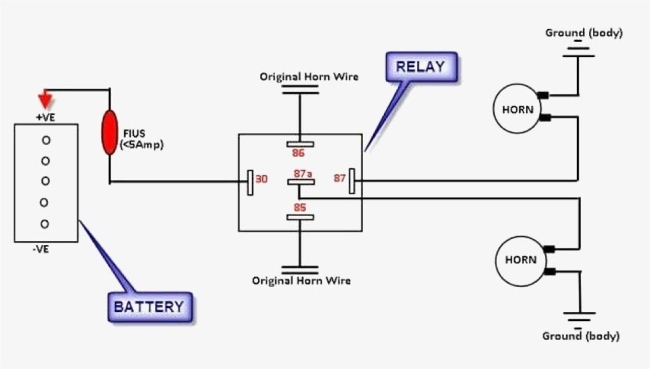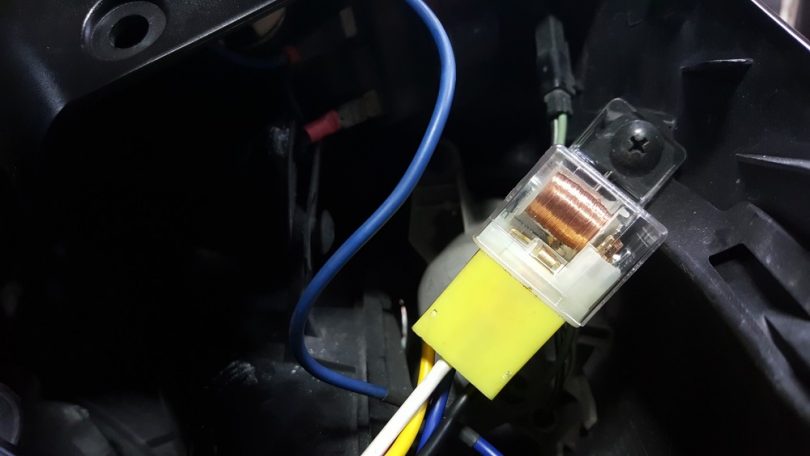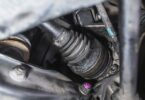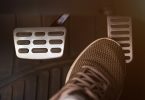Your horn is your communication with other drivers. Without the horn, you have no way to get another driver’s attention, warn pedestrians and bikers you are there, or let a friend know you are waiting. It is inconvenient and dangerous when the horn is not working, especially in bad weather.
Here we will learn to wire the horn relay using provided steps, wire a 4-pin horn relay, and offer tips to make the job quick and easy.
Explaining the horn relay

**Photo Courtesy: Pinterest
The electrical part of your horn’s circuit is the relay. It’s a switch that gets tripped (like a remote control) by a smaller amount of current to start a component that needs a much larger amount of current.
The relay lets you use smaller wires under the hood where there is limited space. This relay controls the power that goes to the horn (using a 12-volt lead). When you honk the horn, power goes to the relay and completes the circuit to the horn.
How to Wire a Horn Relay?
Step 1: Collect your tools and equipment
- Tools
- Wirecutter/stripper
- Multimeter
- 16-gauge wire
- Solderless butt connectors
- 10-gauge wire
- Horn
- Horn relay
Step 2: Disconnect the wire after finding the original horn
Find the original horn and disconnect the wire. Have someone turn the ignition key on and press the horn while using the multimeter to check the wire for 12-volts of current.
If there is no voltage, you will have to check the continuity between the battery’s negative terminal and the wire you just tested.
Step 3: Disconnect the battery
Anytime you are working with engine current, you should disconnect the battery.
Step 4: Locate the relay on terminal 85 and connect the wire
If you have a 12-volt current in step 1, use solderless connectors and a 4-inch piece of 16-gauge wire to attach a metal part on the car to terminal 86.
Step 5: Locate terminal 86 and connect the horn wire
Find terminal 86 and attach the horn wire. Locate terminal 30 and attach it to terminal 85. Different wiring is required between the car’s ground and the horn wire to find continuity.
Step 6: Find a good spot to mount the relay and new horn
Under the hood, find an area close to the battery to put the relay and new horn. The closer you get the relay to the battery, the less wire you will need, saving you some money.
Step 7: Connect one wire from the inline fuse holder to the solderless ring terminal
Connect a wire from the inline fuse holder to a solderless ring terminal, then connect the wire to the battery’s positive terminal. Use 10-gauge wire and the correct solderless connector (a female spade connector is the best choice.)
Step 8: Connect the relay to the horn and terminal 87
Attach the relay to the opposite end of the fuse holder, then attach it to terminal 30. Using the same gauge wire and solderless connector to attach the relay for the horn to connect to terminal 87.
If there are two connectors on your horn, you will need to attach the second connector to a metal part of the car using another solderless connector and 10-gauge wire.
Step 9: Reconnect the battery
Reset the battery and then honk the horn to make sure it is working.
How to Wire the 4-Pin Horn Relay
Step 1: Collect your tools and equipment
- Tools
- Wire stripper/cutter
- 4-pin horn relay
Step 2: Disconnect the battery
Be sure to disconnect the battery before you start.
Step 3: Connect the relay’s coil circuit
Connect the battery’s positive terminal to the coil circuit’s terminal 86, then pad for the horn to terminal 85
Step 4: Connect the high amperage circuit relay
Using the fused wire connected to the fuse box on terminal 30 for the high amperage circuit. Now, connect the horn to terminal 87on the same high amperage circuit. Once it is attached, you have successfully wired the 4-pin horn relay.
Step 5: Don’t forget to toot your horn
Test the horn to ensure it works.
Tips for wiring the horn relay
1. Use a radiator fan relay for more power
Before you use the larger relay, check your owner’s manual wiring illustrations. The standard relay is rated 30A; you can use an 80A radiator relay if you need a larger relay. Be sure to actuate the coil for the larger relay using a wire and the horn.
2. Use a contactor relay if you have an older Ford
Check the owner’s manual for an older Ford. The relay is even larger than the radiator relay at 150A (the radiator relay is 80A.) This relay pushes a lot of power.
3. Read the packaged instructions
The new relay you purchased should come with instructions and, hopefully, illustrations that you can use for the installation. Once you have read those, check them against the owner’s manual.
FAQs
1. Will the car horn relay drain the battery?
Ans. As long as the horn relay has energy, it can drain the battery. The relay drains the battery quicker when it is faulty.
2. Do you have to use a relay to wire the horn?
Ans. Yes, the relay is essential when wiring the horn. The relay helps control the current to the horn’s circuit by delivering the connection to complete the circuit when you honk the horn.
3. Does the relay need to be fused?
Ans. Yes, remember that the fuse protects the relay from frying if there is too much current.
4. How do I know if I’ve blown the relay?
Ans. Here are the signs –
- There is a clicking from under the hood when you honk the horn
- No sound comes when you honk the horn
There is a smell like something is burning










Leave a Comment